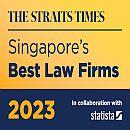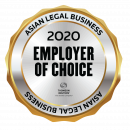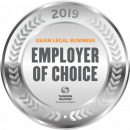M&A to outpace IPOs in ASEAN as entrepreneurial ventures mature: Sze-Hui Goh, Eversheds Harry Elias
*This article, written by Shiwen Yap of Deal Street Asia, was first published by Deal Street Asia on 10 November 2017.
Sze-Hui Goh, a corporate partner at Singapore-based law firm Eversheds Harry Elias, believes that M&A activity (i.e. trade sales and buyouts) is likely to continue outpacing initial public offerings (IPOs) in ASEAN region as the entrepreneurial ecosystem in the region matures and both companies and investors seek an exit.
Goh has advised on both contentious and non-contentious matters in the areas of insolvency, commercial and corporate work in the Asia Pacific, with her practice areas covering cross-border mergers and acquisitions, joint ventures, corporate finance and corporate restructuring.
Goh also believes that it is also too early to predict the impact of initial coin offerings (ICOs) on M&A activity in the region, given the relative immaturity of ICOs as a capital raising process.
In an exchange with DEALSTREETASIA, Goh discusses the development of the entrepreneurial ecosystem in Southeast Asia since 2012, the role of online platforms in M&A, capital markets and ICOs.
Edited excerpts
How has the M&A space in Singapore and Southeast Asia matured since 2012-13, given that period saw a number of transactions (e.g. Zopim and Viki) which served as an inflexion point for the startup ecosystem?
2012 was the tipping point for technology startup funding in Singapore. It was the first time that we saw solid evidence of a genuine market appetite for investing in tech startups to fund both their R&D and expansion.
Five years on and it is clear that the Singapore market has identified tech as one of the ‘hot’ growth sectors. The number of startups is increasing steadily and there are a number of funds that are keen to invest. Indeed, there have been several successful $100-million-plus exits through private trade sales with more to come in 2018.
With online platforms for crowd finance maturing, do you see this also applying to the M&A space, driving great market transparency, or will it continue to be dominated by traditional players?
Crowd finance is an innovative way to attract new investors, combining as it does the twin benefits of easy access to affordability. That said, in my view, M&A will continue to follow the more traditional funding model for the foreseeable future.
Crowd finance is not yet sufficiently mature to attract cornerstone investors. Indeed, given its very nature, crowd finance tends to attract large numbers of small investors/shareholders, which would make even a small deal top-heavy and difficult to manage.
On the other hand, twenty years ago, no one expected technology to have changed our lives so markedly. I suspect that in another ten years the market will have moved significantly, with crowd finance and other new financing models playing a much more prominent role.
What will be required of online M&A platforms to make them viable and trusted as platforms for M&A activity, particularly in Asia?
Successful M&A transactions in Asia, and around the world, rely to a large extent on trust and relationships and it is most unlikely that these elements will ever truly disappear. Online M&A platforms can certainly facilitate introductions and provide a platform to access a wider audience. However, they can only be viable when sufficient players lead and anchor the platform, enabling retail investors to participate.
Any view on the emergence of startup stock exchanges – private exchanges for secondary transactions of startup venture stocks – and their role in the M&A space? Can this potentially be applied to SMEs as well?
The majority of startups are focused on building and growing their business. Dealing with the compliance, governance and regulatory requirements facing all listed companies is unlikely to ever be an attractive proposition for more than a mere handful of startups.
From an investor perspective, a startup exchange would also present significant risks. The general public and retail investors may not necessarily appreciate the level of risk presented by startups. While in theory, startup stock exchanges would provide startups with another potential exit route, I am sceptical as to whether it is really a viable option.
In most markets, SMEs already have secondary boards where they can list although it is possible that they could avail themselves of a startup stock exchange.
Is the middle-market in Singapore and the region being neglected by M&A and PE/VC players, given the focus on tech startups, which tend to be more glamorous?
I do not believe this to be the case. Certainly, it is the tech startups that are grabbing the headlines. It should come as no surprise that technology that makes our lives easier and more efficient will attract more attention than the more traditional ways of doing business. We live in a world that is being changed on a daily basis by technology and we have become increasingly reliant on the benefits that it delivers.
The technology startup scene is relatively new and it is attractive to different players. We are seeing a growing number of mainstream businesses seeking to acquire technology startups with interesting business models. Indeed, in some deals, we are seeing these ‘old model’ businesses competing head-on with VC and PE funds over an acquisition.
Looking at Singapore, the SGX is competing with the likes of HKSE and ASX to be a technology listing venue. What’s your take on its position as a platform and the strengths of other courses?
The SGX has a solid track record of attracting technology listings away from ASX. HKSE, on the other hand, presents a bigger challenge, in particular given its deeper liquidity and more attractive valuations. SGX will need to reconsider its playbook if it is to compete successfully at a regional level.
Any take on the current cycle of delistings/privatisations that the SGX is seeing at the moment? Company owners cite lack of liquidity but what’re the root causes?
In my view, the fundamental driver behind the delistings is the generally low valuations of companies on the SGX. Lower levels of liquidity in Singapore also make it harder for listed companies to raise funds from the equity market while at the same time they face higher costs due to the compliance and reporting obligations placed on them by the SGX. It comes as no surprise that companies that have good growth prospects but low valuations may prefer to delist or even consider listing on other exchanges.
The SGX recently partnered with NASDAQ to form a collaborative listings pact. What sort of medium to long-term impact can we expect from this?
While I applaud this move by SGX I suspect the market impact may be limited. A company that wants to list on NASDAQ, but is not quite ready for whatever reason, may hesitate to pursue their first listing on SGX.
Liquidity issues in this market mean that a newly-listed company may have a low valuation, making it more difficult, and costlier, to raise further capital on another exchange. For this reason, companies will prefer to raise capital privately first until they are ready to list, rather than using one bourse as a platform to gain a listing on a second exchange.
As the entrepreneurial ecosystem in Singapore and ASEAN matures here, will it trend towards M&A activity or will we see more IPOs in regional exchanges?
I am confident that that levels of M&A activity, both in Singapore and more generally across ASEAN, will continue to outperform equity capital markets. For a start, any company considering a listing must have a credible track record and meet certain requirements. In a way, a private sale is still going to be less prohibitive as an IPO.
What impact will the advent of ICOs have on the general M&A activity, given this translates to companies possessing substantial cash piles that can stay private for longer and even explore management buyouts?
ICOs are a relatively new, and immature, product. Until such time as the Singapore Monetary Authority of Singapore provides further guidance I do not anticipate there being particularly high levels of activity.
Last year saw the agglomeration IPO model being practised in Singapore for the first time, with company owners/entrepreneurs sharing a vehicle to list abroad. Is this a viable model in the Asia Pacific context, whether it’s for capital raising or exits?
The agglomeration model could be a viable option for listing on a growth enterprise market where ownership continuity or partners need not be operating together for extended periods prior to any listing.
However, the first example of the agglomeration IPO model is struggling and facing criticism from the market. This may have a negative impact on future agglomeration activity, in particular given the numerous other options that are available.
For more information, please contact our Business Development Manager, Ricky Soetikno, at RickySoetikno@eversheds-harryelias.com.












